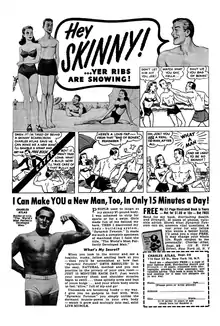
Comic book advertisements are a common feature in American comic books mainly from the 1940s onwards. As these advertisements were directed at young people, many made sensational claims,[1] and sold the products for a few dollars or less, to be sent to a post office box. Products offered included novelty items, toys, and self-improvement courses such as drawing and body building.
Companies
The Johnson Smith Company placed advertisements for gadgets and toys[2] that appeared on the back cover of many historically significant comic books, including Action Comics #1 (June 1938)[3] (the first appearance of the character Superman) and Detective Comics #27 (May 1939) (the first appearance of the character Batman).
Notable products offered
- Charles Atlas illustrated bodybuilding book
- Disappearing ink[4]
- Dribble glass
- Itching powder[5]
- Joy buzzer[4]
- Latex mask
- Potato gun[6]
- Sea-Monkeys[7]
- Sneezing powder
- Squirting flower[8]
- Stink bomb
- Whoopee cushion[9]
- X-ray specs[10]
The ads also included recruitment of youngsters to act as salespeople for products such as greeting cards and the national newspaper Grit.
See also
- Advertising to children
- Soren Sorensen Adams – a Danish-American inventor and manufacturer of novelty products, including the joy buzzer.
- Toy advertising
References
- ↑ By (25 May 2008). "12 Comic Book Ads That Taught Us To Be Cynical". Cracked.com.
- ↑ Comic Book Come-ons that Catch Kids. Kiplinger Washington Editors, Inc. November 1974. pp. 43–46. Retrieved February 6, 2019.
- ↑ Tosh, D. (2015). Picker's Pocket Guide - Comic Books: How to Pick Antiques Like a Pro. F+W Media. p. pt252. ISBN 978-1-4402-4514-5. Retrieved February 6, 2019.
- 1 2 The Thin Man. Cincinnati Magazine. September 2005. p. 58. Retrieved February 6, 2019.
- ↑ "Monkey Madness". NPR.org.
- ↑ New Society. New Society Limited. 1975. p. 697. Retrieved February 6, 2019.
- ↑ Hix, Lisa. "Sea-Monkeys and X-Ray Spex: Collecting the Bizarre Stuff Sold in the Back of Comic Books". Collectors Weekly.
- ↑ American Woodworker. New Track Media. p. 42. Retrieved February 6, 2019.
- ↑ The New York Times Book Reviews 2000. Fitzroy Dearborn. 2001. p. 1706. ISBN 978-1-57958-058-2. Retrieved February 6, 2019.
- ↑ Penkava, Michael. "Penkava: Don't monkey around with comic book ads". www.nwherald.com.
Further reading
- Demarais, K. (2011). Mail-Order Mysteries: Real Stuff from Old Comic Book Ads. Insight Editions. ISBN 978-1-60887-026-4. Retrieved February 6, 2019. 156 pages.
External links
 Media related to Comic book advertisements at Wikimedia Commons
Media related to Comic book advertisements at Wikimedia Commons







